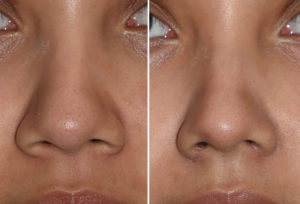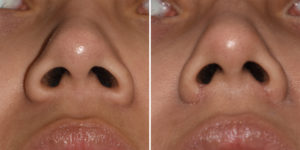Background: There are many elements that make up a desirable shape of the nose. While nostril width is not the most important, it is relevant for some patients and in some rhinoplasty surgeries to help achieve a better nose shape. It is one of the dozen shape considerations when analyzing and planning for a rhinoplasty surgery.
The width of the nose has been studied and numerous measurements have been determined as to what is the ideal nostril width. Keeping the sides of the nostrils between vertical lines drawn down from the pupil, a close to two-thirds width compared to mouth width and what makes for an equilateral or isoceles triangle when the nose is viewed from below. But in the end all that matters is whether the patient sees that their nostrils are too wide. In some patients this has to be shown by computer imaging when the nasal tip shape is changed.
There are numerous methods for reducing nostril width, most of which involve the excision of skin somewhere long the nostril base. One of these methods is nasal sill excision where skin is removed from the floor of the nostril. It is particularly useful when there is a wide nasal floor present in addition to flared or wide nostrils. A diamond shaped skin incision pattern is usually used. The scar ends up at the junction of the nasal sill and the ala. (side wall of the nostril) Many people already have an existing crease there so the scar can be fairly well hidden.
Case Study: This 25 year-old female had wide nostrils that she did not like and wanted them reduced. She was otherwise happy with the rest of her nose shape including the tip.
She underwent multiple other facial procedures under anesthesia so the nostril narrowing was done at the same time. A 4mm nasal sill excision was done in a diamond shape pattern. Resorbable sutures were used for closure.

Nostril narrowing is most often done as part of a rhinoplasty. But infrequently it can be the only part of the nose a patient dislikes. Nostril narrowing surgery by itself can be done under local anesthesia in an office setting.
Highlights:
1) Th width of the nostrils can be narrows by numerous techniques based on the amount of flare and the width of the nasal floor.
2) The nasal sill excision technique for nostril narrowing is effective for moderate nostril flare and with a wide nasal floor.
3) Meticulous placement of the excision and closure can result in very acceptable nasal scars.
Dr. Barry Eppley
Indianapolis, Indiana



